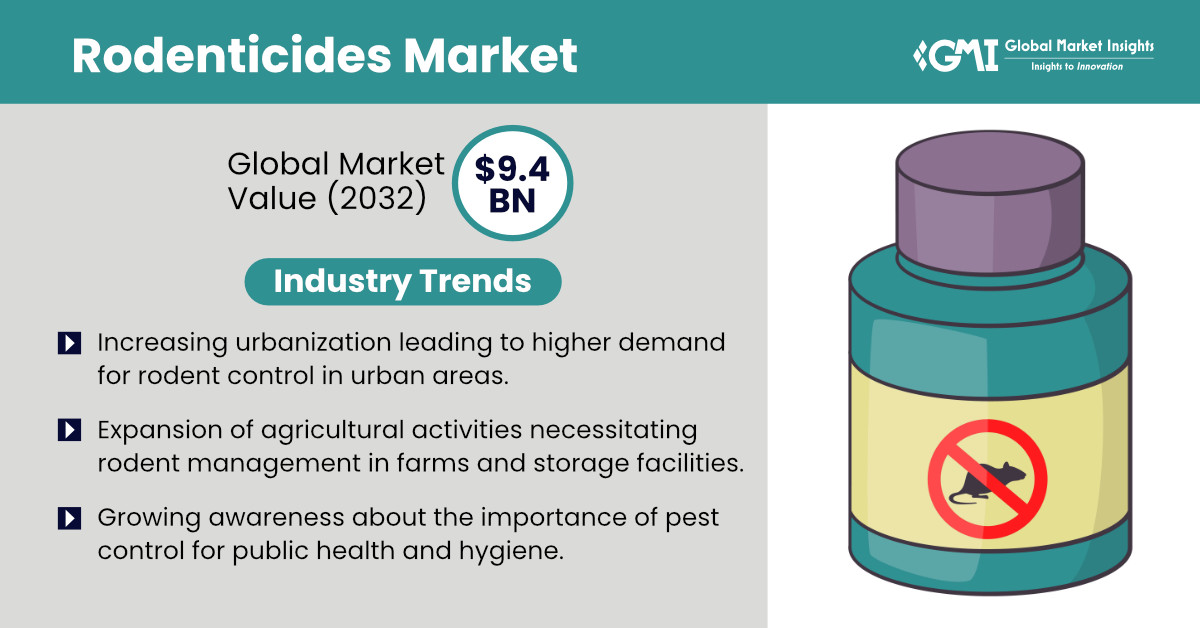Selbyville, Delaware, Aug. 28, 2024 (GLOBE NEWSWIRE) -- Rodenticides Market value could reach USD 9.4 billion by 2032, as per a recent study by Global Market Insights Inc.
The rodenticides industry has seen an increase in demand driven by regulatory emphasis on effective and safe pesticide usage. Government and health officials are introducing stricter regulations to reduce the environmental and health risks associated with common rodenticides. This amendment aims to protect non-target species, including domestic and wildlife, and prevent contamination of land and water sources. In response, manufacturers are developing safe and effective rodenticides that meet these stringent guidelines. Products with reduced toxicity, targeted delivery systems, and biodegradability are becoming more common.
Request for a sample of this research report @ https://www.gminsights.com/request-sample/detail/8690

For instance, in January 2024, the NFU recommended an increase in licensing following the introduction of new certification requirements for pesticides used in agriculture. This development came as the CRRU (Campaign for Responsible Rodenticide Use) announced that from January 2026, all commercial rodenticide suppliers would be required to have an approved rodenticide training certificate. In addition, according to the World Health Organization, rodent-borne diseases account for over 20% of all infectious diseases globally, highlighting the critical need for effective rodent control measures. Furthermore, due to rapid urbanization and infrastructure, rodent infestation in urban areas has increased, and there is a need to develop effective rodent control measures.
Non-anticoagulant type to support market growth
The rodenticides market from the non-anticoagulant segment could exhibit a decent growth rate over 2024-2032, claims the report. Traditional rodenticides cause secondary toxicity to non-target species and must be fed repeatedly to be effective. On the other hand, non-anticoagulant rodenticides tend to work faster and pose less risk to other wildlife and pets. New developments in this category include neurotoxins and metabolic inhibitors, which enable better rodent control with reduced environmental impact. Regulatory pressure and increased environmental awareness are driving this shift towards safer alternatives. As consumers and companies seek more responsible pest control solutions, the demand for non-anticoagulant rodenticides continues to grow, showing a broad trend toward sustainability in pest control.
Block form to expand market reach
The rodenticides market size from block segment will register a noteworthy CAGR from 2024 to 2032, as per the report. The block disinfectants are designed to withstand various environmental conditions, making them suitable for both indoor and outdoor applications. Their durable properties prevent wear and tear, allowing them to work for long periods. These pieces are often infused with scents and flavors to attract rodents and deter them from attacking non-target prey. Direct users reduce the need for frequent inspection and replacement, which is attractive for both commercial and residential users. As a result, the market for blocks segments is expanding, and the need for effective, non-invasive, and environmentally friendly block solutions is on the rise.
Make an inquiry for purchasing this report @ https://www.gminsights.com/inquiry-before-buying/8690
Europe to garner a high market value
Europe rodenticides market will register a robust CAGR from 2024 to 2032. Stricter EU regulations on the use of pesticides, including rodenticides, emphasize safety and sustainability, which has created a demand for improved solutions. Additionally, being environmentally friendly and having rapid urbanization and agricultural expansion creates the need for effective rodent control to protect crops, infrastructure, and public health. Therefore, the region combines chemical and non-chemical methods to effectively control rodents. European users and industry are therefore dependent on newly developed rodenticides that improve efficacy with a reduced environmental footprint around the area, boosting market demand across the region.
Rodenticides Market Players
Neogen Corporation, BASF SE, EcoClear Products, Syngenta, Bell Labs, Impex Europa S.L., Anticimex, Rentokil Initial plc, PelGar, Liphatech, Inc., Bayer AG, UPL Limited. Through targeted efforts to develop safe and effective products, companies are driving demand in the rodenticides industry. Innovations in pharmaceutical manufacturing, such as non-anticoagulant rodenticides and environmentally friendly nets, comply with regulatory and consumer concerns about safety.
Leading companies are investing in R&D to develop advanced rodenticides that meet stringent regulations and improve their efficacy. In addition, companies focus on user-friendly methods such as block forms and promote integrated pest management (IPM) methods supporting market adoption.
In June 2024, Bell Laboratories introduced its latest rodent bait to Canada, the Fastrac Soft Bait. The active ingredient in this powerful rodenticide was bromethalin. It was formulated with a special oil blend that balanced saturated and neutral fatty acids.
About Global Market Insights
Global Market Insights Inc., headquartered in Delaware, U.S., is a global market research and consulting service provider, offering syndicated and custom research reports along with growth consulting services. Our business intelligence and industry research reports offer clients with penetrative insights and actionable market data specially designed and presented to aid strategic decision making. These exhaustive reports are designed via a proprietary research methodology and are available for key industries such as chemicals, advanced materials, technology, renewable energy, and biotechnology.
